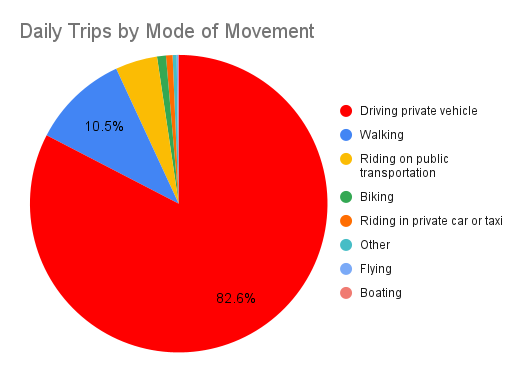Combining Car Trips: Improve How You Move
It’s summer, time to get outside and move your body! (Unless you’re in a scorched place on the planet where this could be hazardous to your health.) This month’s action guides are about sustainable movement, including transportation, exercise, and more.
Almost everyone in the United States knows the price of a gallon of gas, because buying and burning it is how we move most things most of the time, including ourselves and the goods we buy. For more than four out of five trips, we drive a private vehicle. Not only that, but we often drive alone: the average vehicle occupancy in the United States declined from 1.87 people in 1977 to 1.5 people in 2019.
Combining car trips is this week’s sustainability step. Whether you drive fuel-burning or battery electric vehicles, try increasing the person-days per car start per week for your household or organization while getting where you need to go. (Confused by a “person-day”? Don’t worry, it’s easy to measure and I’ll explain how!)

We Really Like to Drive Ourselves
Data from the US Federal Highway Administration’s National Household Travel Survey shows how much we prefer to drive, compared to other modes of movement.

Of all the “alternative” forms of moving from place to place (besides driving a private vehicle), walking is the most popular.

I’ve always felt like bicycling should get more love from transportation planners, but these statistics show the problem: it’s a small slice of a small slice of daily trips. Here in North America, the pathway to sustainable movement has to consider private cars.
Weekly Poll: Car Starts Per Week
EVs and Bicycles Are Great, But First…
Later in July, I’ll cover renting, leasing, or owning an electric vehicle, and I'll also extoll bicycles, which are truly extraordinary technological marvels. But first, let’s make better use of the hundreds of millions of fuel-burning vehicles already in circulation.
When I say combining “car” trips, I’m including SUVs, vans, and trucks. We’re talking about automobiles that can carry many passengers or packages hundreds of miles in a few hours. Firing up one of these incredibly powerful machines to drive around the block for a loaf of bread is like using a flamethrower to light a candle.
There are at least three things to consider combining to reduce car trips:
Combine multiple errands into a single trip, by resisting the urge to dash out and instead carefully planning before you get in the vehicle.
If you’re ordering products online which will require someone to deliver them to you, combine orders so that you receive just one delivery.
Combine passengers by carpooling. Going from one passenger to two doubles your sustainability; from one to three triples it.
Sustainability Metric: Person-Days per Car Start
Every action guide explores a sustainability step that you can take to make the world better for everyone, now and far into the future. This week we measure your positive impact by person-days per car start per week for your household or organization.
Maximizing “person-days” and minimizing “car starts” allows more people to live better on our planet. You might not be familiar with the concept of a “person-day”: it just means multiplying the number of people by the number of days. (This type of measurement across time is common in sustainability metrics—a “kilowatt-hour” is a similar idea: multiply the number of kilowatts by the number of hours.) A “car start” is how many times you start driving a car. Every car start produces some pollution, consumes some resources, and creates some risk of injury or death.
Calculating Person-Days per Car Start
If your household has three people, in a week you have:
3 persons x 7 days = 21 person-daysIf you have two cars and start them three times a day, in a week you have:
2 cars x 3 starts per day x 7 days per week = 42 car starts per weekYou have 21 / 42 = 0.5 person-days per car start per week.
If you could carpool so that you were only using one car per day, you could double this sustainability metric to 1 person-day per car start per week.
If you begin combining car trips, you’ll see your “person-days per car start” increase. Measuring this over a couple of weeks, you’ll get a sense of where you are. Then you can set goals for improving while still satisfying your need to move yourself and your possessions from place to place.
Why focus on “car starts” rather than “miles driven”? It’s good to drive fewer miles, but it’s even better not to start your car at all. This is especially true for fuel-burning cars (including hybrids) because when their engine first starts after cooling down, it creates much more pollution than after it has had a chance to warm up.
In a cold start, the engine is cold, the fuel mixture is rich, and the catalytic converter is cold and ineffective. Even well-tuned engines will produce over 80,000 [parts per million of carbon monoxide pollution] for the first minute or two of operation. The CO concentration will typically drop to 1,000 ppm or less after 5 to 15 minutes of operations. In one Iowa example, an engine produced over 80,000 ppm for 3-minutes. The concentration dropped to 60,000 for the next 2-minutes and then continued to drop. After 15 minutes the engine was producing only 300 ppm.
—Carbon Monoxide Poisoning: Garages (AEN-207)
Another Way to Combine—and Another Sustainability Metric
Private car ownership is the norm in North America; many households own not just one but several cars. Combining ownership—sharing a car—is another way to explore this week’s action step. If you can reduce the number of cars your household or organization owns, you can increase the number of people per car. In general, the more people per car, the better for sustainability, unless it harms the ability of your household or organization to get necessary things done.
The idea of sharing a car rather than having exclusive ownership brings up the difference between deprivation and sustainability. The mission of Sustainable Practice is to help you become superbly sustainable. If sharing a car doesn’t allow you to meet your needs—for example, if you can’t get to work because someone else is using the car when you need it—that’s not really a sustainable solution, and certainly not superb.
Sustainability is about meeting our needs in ways that don’t compromise the ability of others to meet their needs, too. It’s not sustainable to fail to meet our own needs, just as it’s not sustainable to deny others the ability to meet their needs.
But there is also a difference between desires and needs. It might be nice for you to own a car, but do you really need your own? Could you share? It’s not sustainable to try to gratify every whim or desire. Reaching milestones on pathways to sustainability requires discerning the difference between a “nice to have” and a necessity.
We all do need to move ourselves and our belongings from place to place. The sustainability step we’re considering this week is to explore how to do multiple errands on one trip, carry multiple passengers or packages, or share vehicle ownership in ways that work well for everyone involved.
Questions? Comments?
I’d love to know if you’ve discovered ways forward on the pathway to sustainable movement. What has worked well—and what hasn’t been that great—for you?
